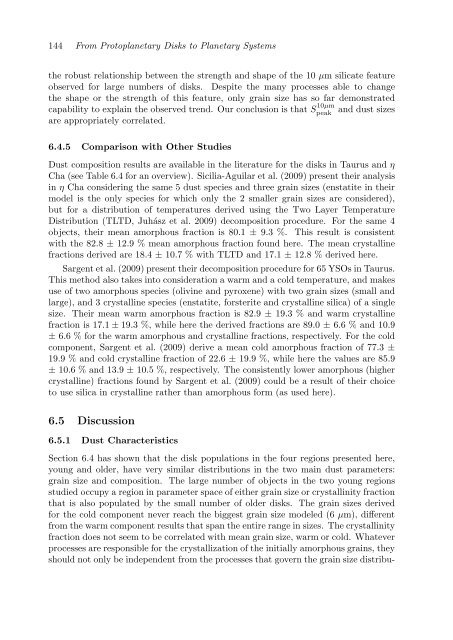Observational Constraints on The Evolution of Dust in ...
Observational Constraints on The Evolution of Dust in ...
Observational Constraints on The Evolution of Dust in ...
You also want an ePaper? Increase the reach of your titles
YUMPU automatically turns print PDFs into web optimized ePapers that Google loves.
144 From Protoplanetary Disks to Planetary Systems<br />
the robust relati<strong>on</strong>ship between the strength and shape <strong>of</strong> the 10 µm silicate feature<br />
observed for large numbers <strong>of</strong> disks. Despite the many processes able to change<br />
the shape or the strength <strong>of</strong> this feature, <strong>on</strong>ly gra<strong>in</strong> size has so far dem<strong>on</strong>strated<br />
capability to expla<strong>in</strong> the observed trend. Our c<strong>on</strong>clusi<strong>on</strong> is that S 10µm<br />
peak<br />
and dust sizes<br />
are appropriately correlated.<br />
6.4.5 Comparis<strong>on</strong> with Other Studies<br />
<strong>Dust</strong> compositi<strong>on</strong> results are available <strong>in</strong> the literature for the disks <strong>in</strong> Taurus and η<br />
Cha (see Table 6.4 for an overview). Sicilia-Aguilar et al. (2009) present their analysis<br />
<strong>in</strong> η Cha c<strong>on</strong>sider<strong>in</strong>g the same 5 dust species and three gra<strong>in</strong> sizes (enstatite <strong>in</strong> their<br />
model is the <strong>on</strong>ly species for which <strong>on</strong>ly the 2 smaller gra<strong>in</strong> sizes are c<strong>on</strong>sidered),<br />
but for a distributi<strong>on</strong> <strong>of</strong> temperatures derived us<strong>in</strong>g the Two Layer Temperature<br />
Distributi<strong>on</strong> (TLTD, Juhász et al. 2009) decompositi<strong>on</strong> procedure. For the same 4<br />
objects, their mean amorphous fracti<strong>on</strong> is 80.1 ± 9.3 %. This result is c<strong>on</strong>sistent<br />
with the 82.8 ± 12.9 % mean amorphous fracti<strong>on</strong> found here. <strong>The</strong> mean crystall<strong>in</strong>e<br />
fracti<strong>on</strong>s derived are 18.4 ± 10.7 % with TLTD and 17.1 ± 12.8 % derived here.<br />
Sargent et al. (2009) present their decompositi<strong>on</strong> procedure for 65 YSOs <strong>in</strong> Taurus.<br />
This method also takes <strong>in</strong>to c<strong>on</strong>siderati<strong>on</strong> a warm and a cold temperature, and makes<br />
use <strong>of</strong> two amorphous species (oliv<strong>in</strong>e and pyroxene) with two gra<strong>in</strong> sizes (small and<br />
large), and 3 crystall<strong>in</strong>e species (enstatite, forsterite and crystall<strong>in</strong>e silica) <strong>of</strong> a s<strong>in</strong>gle<br />
size. <strong>The</strong>ir mean warm amorphous fracti<strong>on</strong> is 82.9 ± 19.3 % and warm crystall<strong>in</strong>e<br />
fracti<strong>on</strong> is 17.1 ± 19.3 %, while here the derived fracti<strong>on</strong>s are 89.0 ± 6.6 % and 10.9<br />
± 6.6 % for the warm amorphous and crystall<strong>in</strong>e fracti<strong>on</strong>s, respectively. For the cold<br />
comp<strong>on</strong>ent, Sargent et al. (2009) derive a mean cold amorphous fracti<strong>on</strong> <strong>of</strong> 77.3 ±<br />
19.9 % and cold crystall<strong>in</strong>e fracti<strong>on</strong> <strong>of</strong> 22.6 ± 19.9 %, while here the values are 85.9<br />
± 10.6 % and 13.9 ± 10.5 %, respectively. <strong>The</strong> c<strong>on</strong>sistently lower amorphous (higher<br />
crystall<strong>in</strong>e) fracti<strong>on</strong>s found by Sargent et al. (2009) could be a result <strong>of</strong> their choice<br />
to use silica <strong>in</strong> crystall<strong>in</strong>e rather than amorphous form (as used here).<br />
6.5 Discussi<strong>on</strong><br />
6.5.1 <strong>Dust</strong> Characteristics<br />
Secti<strong>on</strong> 6.4 has shown that the disk populati<strong>on</strong>s <strong>in</strong> the four regi<strong>on</strong>s presented here,<br />
young and older, have very similar distributi<strong>on</strong>s <strong>in</strong> the two ma<strong>in</strong> dust parameters:<br />
gra<strong>in</strong> size and compositi<strong>on</strong>. <strong>The</strong> large number <strong>of</strong> objects <strong>in</strong> the two young regi<strong>on</strong>s<br />
studied occupy a regi<strong>on</strong> <strong>in</strong> parameter space <strong>of</strong> either gra<strong>in</strong> size or crystall<strong>in</strong>ity fracti<strong>on</strong><br />
that is also populated by the small number <strong>of</strong> older disks. <strong>The</strong> gra<strong>in</strong> sizes derived<br />
for the cold comp<strong>on</strong>ent never reach the biggest gra<strong>in</strong> size modeled (6 µm), different<br />
from the warm comp<strong>on</strong>ent results that span the entire range <strong>in</strong> sizes. <strong>The</strong> crystall<strong>in</strong>ity<br />
fracti<strong>on</strong> does not seem to be correlated with mean gra<strong>in</strong> size, warm or cold. Whatever<br />
processes are resp<strong>on</strong>sible for the crystallizati<strong>on</strong> <strong>of</strong> the <strong>in</strong>itially amorphous gra<strong>in</strong>s, they<br />
should not <strong>on</strong>ly be <strong>in</strong>dependent from the processes that govern the gra<strong>in</strong> size distribu-
















